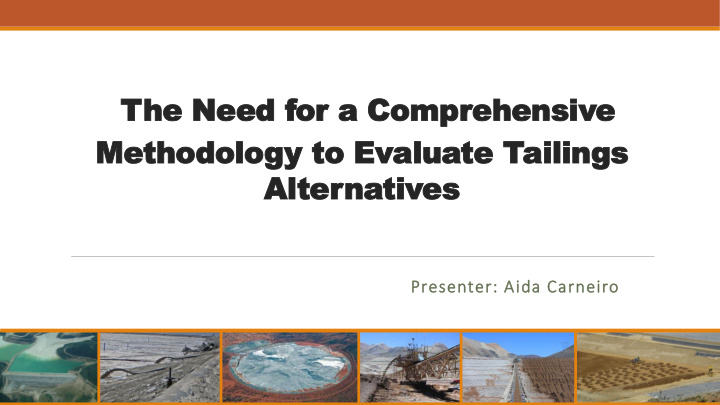



The Need for a Comprehensive Methodology to Evaluate Tailings Alternatives Presenter: Aida Carneiro
2 Content What are Tailings ? How can we dispose tailings ? Reflections & Take-home lesson
3 What are Tailings? • Material left over after the mineral processing operation • Ground rock + process effluents • Retaining structures or or in the form of piles (dry stacks ) • No financial gain • Most cost effective (regulations and site specific factors) • One of the largest elements of risk management and cost for a mine (Kerr and Ulrich, 2011)
4 What are Tailings? THE MINE PRODUCTION CYCLE Increase realised benefits & Concentrate increase costs??? Mineral Slurry Tailings Run-of-mine Processing (ROM) Plant Thickened Tailings Tailings Storage Tailings Facilities (TSFs) Paste Tailings Filtered Tailings
5 Common Alternative Options for Surface Tailings Disposal Source: Taguchi, 2014
6 Conventional Slurry Tailings • < 45% solids • Surface retaining structure • Aim of reclaiming the water for use in the processing plant as required • Two types of surface impoundments • Water retention type dam Upstream • Raised embankment Downstream Centreline Source: http://www.mining-technology.com/projects/highland/highland5.html
7 Conventional Slurry Tailings Source: Taguchi, 2014 Embankment
8 Thickened Tailings • 45% < % solids < 65% • Mechanical process of dewatering low solids concentrated slurry • Homogeneous non-segregated mass upon deposition • The idea is to stack the pulp to form a self supporting conical pile reduced height and retention forces of the embankments • Source: http://www.tailings.info/disposal/thickened.htm Higher operating costs (dewatering)
9 Paste Tailings • 65% < % solids < 70% • High rate and deep cone thickeners • Flocculants and coagulants • Tailings significantly dewatered Source: http://www.tailings.info/disposal/paste.htm • do not segregate • produce minimal bleed water when discharged • Paste deposited to form a conical pile Source: http://www.srk.co.za/files/File/South- • Layers of paste cease to flow desiccation cracks new layer Africa/publicDocuments/Royal_Bafokeng_Styldrif/Nov2015/Appendi ces/Appendix_Q_Design_Docs.pdf
10 Filtered Tailings • >70% solids (80% < % solids < 85% ) • Vacuum or pressure filtration • Not transported by pipeline (MC < 20%) Source: http://www.tailings.info/disposal/drystack.htm self-supporting • Conveyor or truck placed spread compacted tailings stack • Stable deposit (no em bankment for retention) • High capital and operating costs Source: Cooling, 2015 Mechanical dewatering process Costs
11 Major Challenges Drivers for a holistic approach to evaluate tailings alternatives • Water Scarcity • Regulations • Risk of Failure • Valuation Methods used for Long-term Projects (Net Present Value)
12 Water Scarcity • Water Issues • High-level pressure regarding water usage • Handling water: arid and cold regions • Limitation of water supply (conflict mining x agriculture) • Pumping water for long distances • Water = Costs • Pipe and Pump • Purchase of water rights • Establishment of bore fields • Government usage or license fees
13 Regulations • Environmental regulations are increasing pressure placed on mining • Tailings disposal practice is firmly on the regulatory and public agendas • Environmental management = key variable in the business • Environmental quality standards and technology to protect the environment • Public awareness about environmental issues (Social License to Operate)
14 Risk of Failure • Failures = breaching of the containing embankment structure contamination of groundwater • Small pond = reduced potential for water to transport large volumes of tailings Probability of Occurrence According to Taguchi, 2014: • Dewatered tailings have lower likelihoods of failure • The likelihood of tailings release from dewatered facilities is about 65% less Source: Taguchi, 2014
15 Risk of Failure 32,000,000 m 3 Village of Bento Rodrigues Clean-up Costs 15 years Agreement US$1.7 Billion for the next 6 years depending on the remediation and compensation Source: http://www.abc.net.au/news/2016-02-29/bhp-samarco- projects dam-collapse-brazil-linked-to-ramping-up-production/7201022
16 Valuation Methods used for Long-term Projects (e.g. NPV) NPV = Cash Inflows - Cash Outflows Discounted Costs for Closure and C t = $1,000,000 Rehabilitation $ 140,000 r = 7% ( d i s c o u n t r a t e s u s e d b y m i n i n g e n t i t i e s f o r c l o s u r e a n d r e h a b i l i t a t i o n c o s t s ) $1,000,000 t = 30 years NPV = $140,000
17 Valuation Methods used for long-term Projects (e.g. NPV) Drawbacks of of NPV: • Future remediation costs are substantial (under-emphasised) • Pressure to maximise shareholder value (profits in the short term) High density tailings disposal methods Additional initial capital expenditure Disfavored due to continued managerial emphasis on deferring expenditure
18 Realised Benefits of Dewatered Tailings Disposal • Water recovery • Less losses with seepage, interstitial water, and evaporation • Cost savings (make-up water and reagents) • Decreased land footprint • Progressive rehabilitation (spreading the cost of closure over a longer time period) • Lower reclamation and closure costs (reduced footprint and stable surface ) • Mitigated risks of catastrophic failure and tailings runout
19 Reflection • Non-monetary benefits should be taking into account Technical Environmental • Integrated tailings management Social Economic Risks • Dewatered tailings have addressed many environmental problems • Avoid some valuation methods • Adoption of tailings options resulting in sustainable long-term benefits • Sustainability = Economic impact + environmental burden + social indicators = sustainable objectives into reality Effective tailings management lies at the heart of creating a sustainable mining industry
Questions? THANK YOU!
Recommend
More recommend